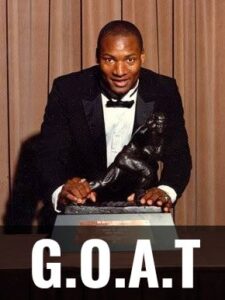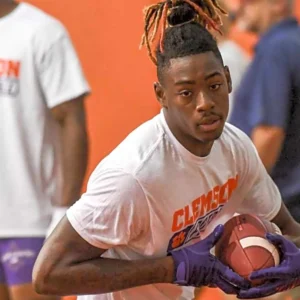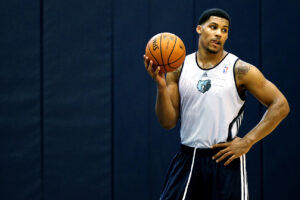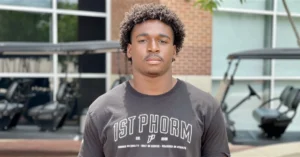Jalen Milroe: A Talented Athlete, but Still a Work in Progress as an NFL Quarterback
Jalen Milroe, the starting quarterback for the Alabama Crimson Tide, has become one of the most polarizing figures in college football. His electric athleticism, strong arm, and big-play ability have excited Alabama fans and intrigued scouts. However, for all his raw talent, Milroe remains a work in progress. As of now, he is not yet a legitimate NFL quarterback prospect. While there is certainly potential for him to become one, the leap from college to the NFL is massive, and Milroe has a considerable amount of development ahead of him before he can be seriously considered as a future pro.
In this article, we’ll explore Milroe’s strengths, identify the key areas where he must improve, and compare his development to other quarterbacks who have successfully transitioned to the NFL. We’ll also consider the challenges that college quarterbacks face in adapting to the professional game and why Milroe’s current skill set falls short of what NFL teams expect from starting-caliber quarterbacks.
To understand why Milroe is even in the NFL conversation at all, it’s important to acknowledge what makes him intriguing.
Milroe is an explosive athlete. At 6’2″ and around 220 pounds, he has the frame and speed that allow him to evade pressure, extend plays, and take off for long runs. He’s more than capable of breaking a defense with his legs, and his rushing ability opens up the playbook for zone reads, RPOs, and designed quarterback runs. NFL teams increasingly value mobility in quarterbacks, so Milroe’s athleticism is a valuable asset.
Milroe possesses one of the strongest arms in college football. He can effortlessly launch deep balls 60+ yards downfield and stretch the defense vertically. This trait gives offensive coordinators the flexibility to call aggressive, downfield passing plays and keeps safeties honest. Scouts often get excited about quarterbacks who can make all the throws, and Milroe can, in theory, make them all from a physical standpoint.
Despite facing heavy criticism and pressure during his tenure at Alabama, Milroe has shown mental toughness and composure. He’s bounced back from poor performances and handled a challenging quarterback competition. That resilience is a necessary trait for NFL quarterbacks who must endure adversity.
While Milroe’s physical tools are impressive, the NFL demands more than raw athleticism. Quarterbacks must process quickly, read defenses pre- and post-snap, deliver accurate throws under pressure, and consistently execute within structure. These are the areas where Milroe has the most work to do.
Arguably the most glaring issue with Milroe is his decision-making. He frequently locks onto his first read and struggles to progress through his options. If the primary route isn’t open, he often pulls the ball down and scrambles rather than working through the progression or manipulating the defense with his eyes.
NFL defenses are faster, more complex, and better at disguising coverages. Quarterbacks must be able to read defenses both before the snap and while the play is unfolding. Milroe’s current decision-making isn’t fast or sharp enough for the pro level. Far too often, he misses open receivers or forces throws into coverage. These are the kinds of mistakes that lead to turnovers in the NFL.
Milroe has a cannon for an arm, but he lacks consistent accuracy—especially on short to intermediate throws. While he can make the deep shot look effortless, his touch and timing on slants, outs, curls, and seam routes are inconsistent. Throws are frequently behind, low, or high, forcing receivers to adjust and limiting yards after the catch.
NFL quarterbacks must be pinpoint accurate, especially in the quick game. Windows are smaller, defenders are faster, and drives stall if throws are even slightly off-target. Milroe’s completion percentage doesn’t tell the full story; his ball placement issues undermine the rhythm of the offense and create missed opportunities.
Milroe’s athleticism is a double-edged sword. While he can escape pressure, he too often relies on his legs to avoid trouble instead of maneuvering within the pocket. He has a tendency to flee clean pockets and abandon plays prematurely, which won’t work against disciplined NFL defenses.
Additionally, his footwork and throwing mechanics are inconsistent. He doesn’t always set his feet or maintain a balanced throwing platform, which contributes to his accuracy issues. At the NFL level, mechanics need to be second nature; otherwise, quarterbacks struggle with consistency.
Another area where Milroe must improve is throwing with anticipation. He often waits for receivers to come open instead of throwing them open. This delay gives defenders time to react and close windows. In the NFL, quarterbacks don’t have the luxury of waiting for receivers to become obviously open—they must anticipate where the receiver will be and release the ball with timing.
This skill is particularly important in tight-window throws across the middle or in red zone situations, where hesitation can lead to deflections or interceptions. Milroe needs to develop trust in the timing of routes and his ability to deliver accurately under pressure.
Modern NFL offenses are increasingly reliant on quarterbacks who can process quickly. That means reading complex coverages, identifying blitzes, adjusting protections, and making snap decisions. Milroe has not yet shown that he can operate at that mental speed. Too often, he holds onto the ball too long or makes a late decision, which results in negative plays or missed opportunities.
Processing speed separates college stars from NFL starters. It’s the difference between getting sacked on 3rd and 6 and hitting the hot read for a first down. Milroe will need to drastically improve his mental processing to succeed in a league where milliseconds matter.
Milroe’s development trajectory is not unique. Many college quarterbacks with elite tools have faced similar criticism. Some have overcome those flaws; others haven’t.
Josh Allen, for instance, entered the NFL with serious questions about accuracy and decision-making. Through elite coaching, relentless work ethic, and time, he refined his game and became one of the league’s top quarterbacks. Allen’s story is an example of how raw talent can be molded—but it’s the exception, not the rule.
Others like Malik Willis, Tyree Jackson, and Jalen Hurts (in his early days) also showcased athleticism but struggled with the finer points of quarterbacking. Hurts eventually grew into a high-level NFL starter after years of development. Willis, however, has yet to make that leap and may never do so.
The point is, the leap to the NFL requires not just talent, but refinement, mental sharpness, and adaptability—areas where Milroe has significant ground to cover.





